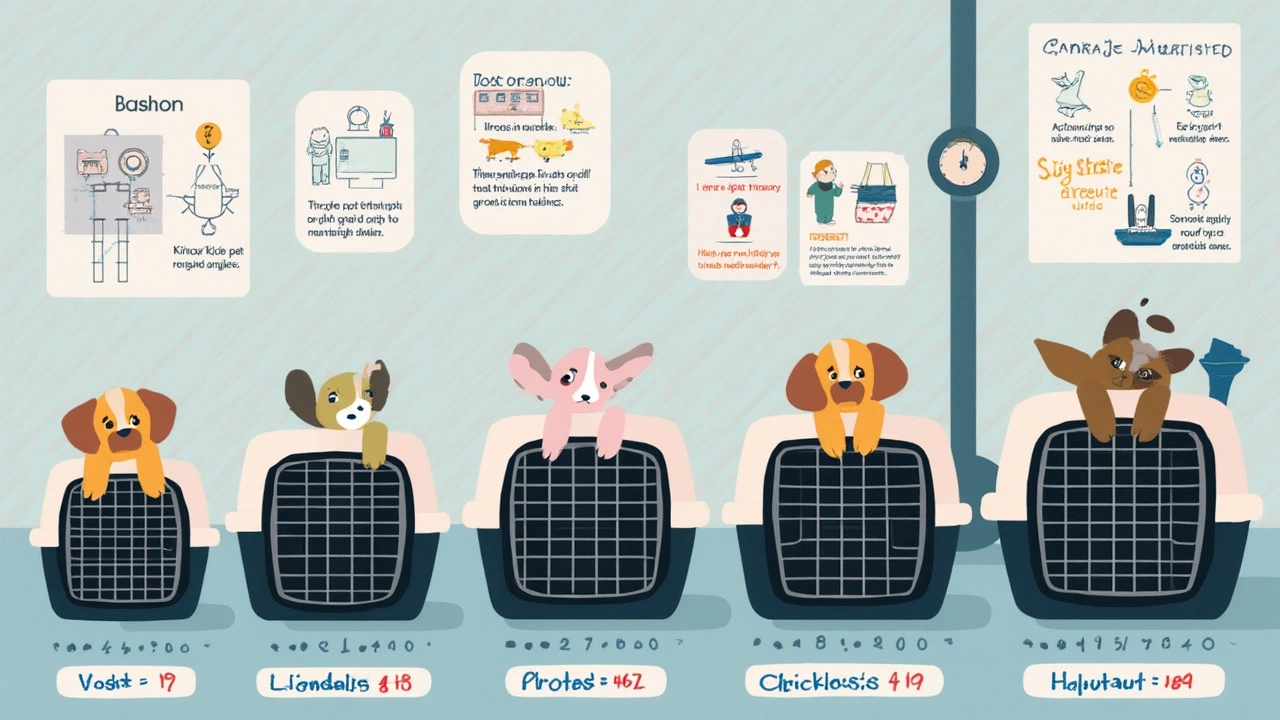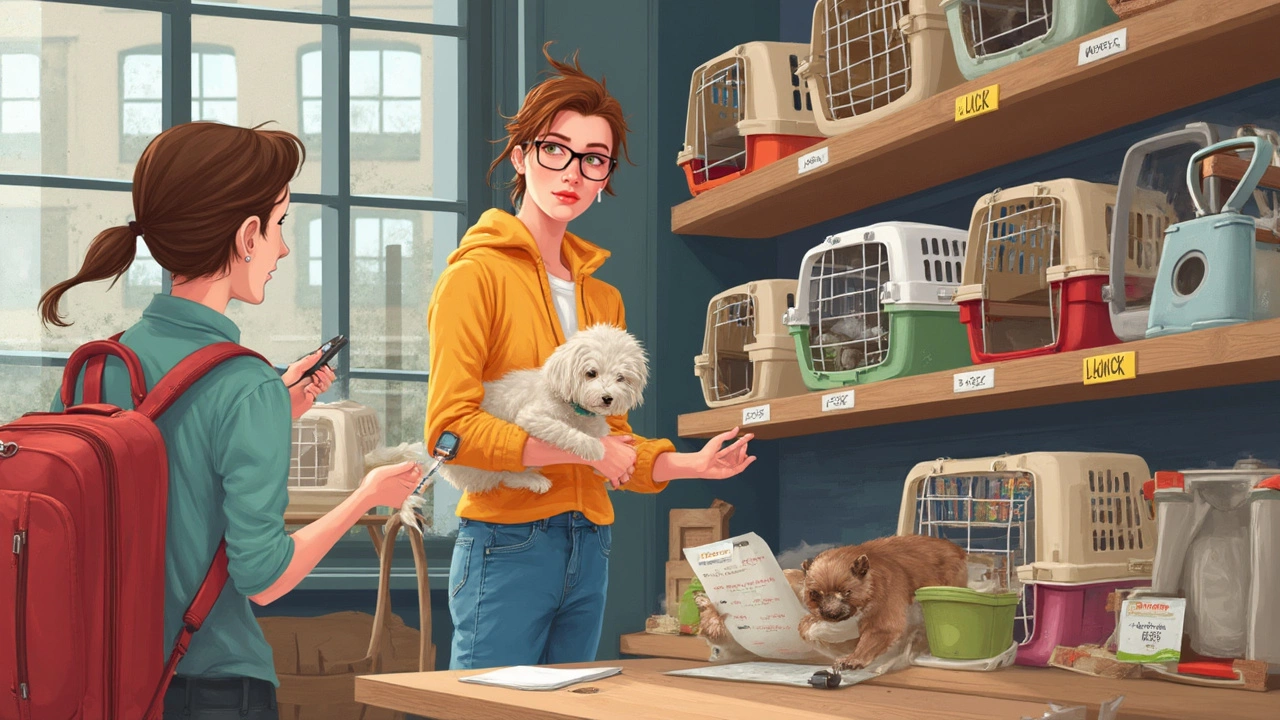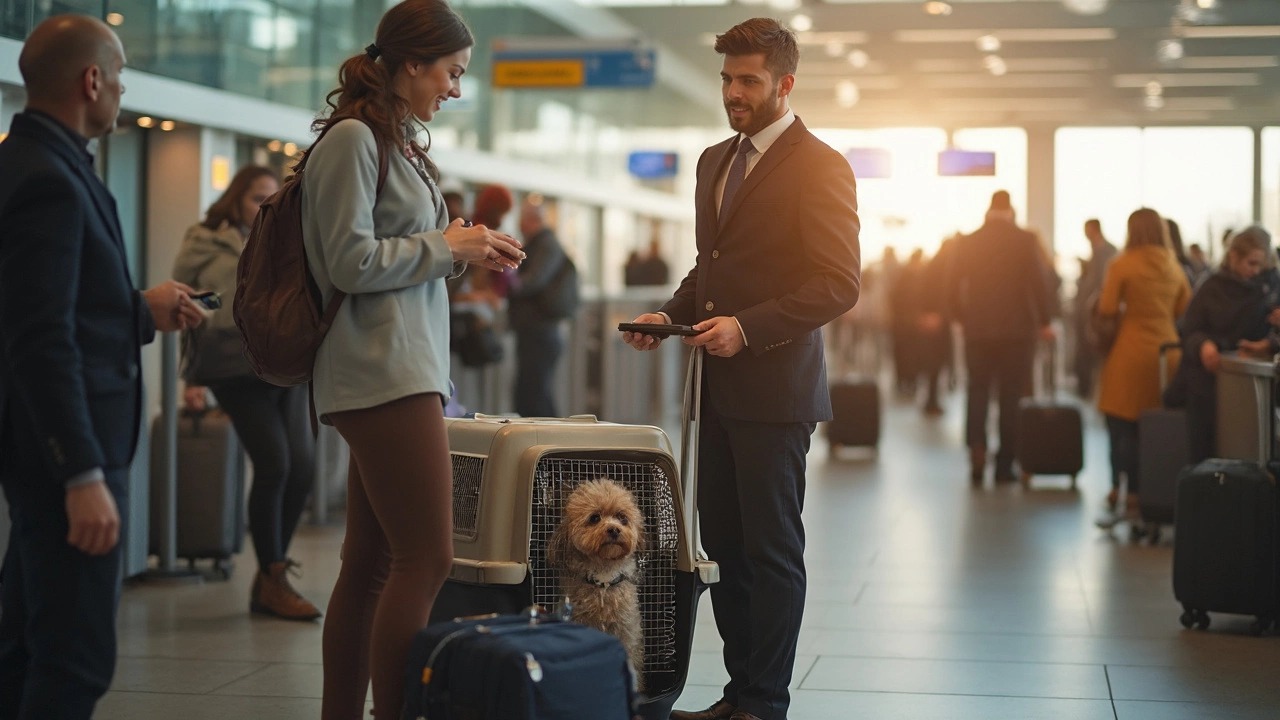Ever watched someone in an airport wrestling with a pet carrier that looks more like a mini luggage cart than a cozy spot for a furball? I've seen it—and it usually ends with stressed-out travelers begging a gate agent for mercy. Traveling with pets sounds simple: get a carrier, buy a ticket, and off you go, right? Not so fast. The size of your pet’s carrier can make or break your trip, and, yes, airlines do check. Not sometimes. Not when they’re bored. They really do check—especially if you’re flying with your little buddy in the cabin. What you do next matters way more than you think.
The Real Deal: Do Airlines Actually Check Pet Carrier Size?
The myth that you can just ‘wing it’ with a too-big pet carrier lives on because, sometimes, folks sneak by without anyone batting an eye. But that’s more luck than the norm. Most major airlines enforce strict size requirements for in-cabin carriers. For instance, Delta, United, and American Airlines all have maximum size limits, usually something like 18" x 11" x 11" (45cm x 28cm x 28cm) for soft-sided carriers—give or take an inch depending on the airline. This isn’t just an arbitrary rule; the carrier needs to fit under the seat in front of you. You can’t buy an extra seat for Bruno or Misty. The rules don’t bend, even if your pet gives the staff those big, sad eyes.
Now, do gate agents whip out rulers at every flight? Not always, but don’t count on skating by with a jumbo carrier. At check-in, most airlines will want to actually see your pet inside the carrier. If you show up with something too big, you risk getting turned away right at the counter. United, for example, specifically lists their approved carrier dimensions by plane type on their website. Front desk staff are trained to eyeball carrier size, and some even use measuring templates at the counter. If it won’t fit, you won’t fly—at least not with your pet in-cabin. A friend of mine got caught with a carrier just an inch over the limit last year. She said, "The staff were perfectly polite, but firm. They wouldn’t budge, even after I tried explaining my cat would just curl up small anyway."
If you’re checking a pet as cargo, rules are just as specific but can vary more airline-to-airline. Oversized kennels can get you booted to another flight (if your animal can’t fit), or you’ll end up scrambling for one of the airline’s expensive approved kennels. Don’t risk it. Remember, the airline’s rules are usually checked at two points: check-in and at the gate. Fed up staff have seen it all before, and empathy only stretches so far when safety is on the line. It’s not just about fitting under the seat. Overlarge carriers can be unstable in turbulence, and a stressed pet that can wriggle out is a hazard for everyone. Best bet: stick to guidelines, measure carrier height, width, and depth yourself, and double-check your airline’s rules before booking. If you must fudge it, even by half an inch, know that you’re taking a gamble with your entire travel plan.
Different Airlines, Different Rules: How Pet Policies Stack Up
Oh, the joys of booking pet travel—until you realize no two airlines seem to agree on exactly what counts as an ‘approved’ carrier. Let’s look at some well-known U.S. airlines to start. American Airlines allows soft-sided carriers up to 18" x 11" x 11" and hard-sided up to 19" x 13" x 9". But United Airlines? They stick to 18" x 11" x 11" period—soft-sided only, and they even state that soft carriers may slightly exceed if they can still be squished to fit under the seat. Delta gets even more granular, referring you to a seat chart: depending on your aircraft, the under-seat space could vary, so you need to check your specific flight details in advance.
International airlines can throw even more curveballs. For example, Air France caps carrier sizes at 18" x 13" x 9" (46 x 33 x 24 cm), but not all seats are pet-friendly, and there are breed restrictions. Japan Airlines limits weights and has carrier size limits at 17" x 11" x 9". Lufthansa gets super technical—they require waterproof carriers with solid construction, and their max cabin size is 22" x 16" x 9". The EU also has strict import/export animal regulations, so count on paperwork in addition to measurements.
One reliable thing: every single airline wants your pet to turn around easily, stand up, and lie down. You can’t just smush your pet in and call it good. I always imagined Misty, my adventure-prone cat, would just loaf quietly at my feet, but nope—she’s a squirmy little escape artist. A too-cramped carrier equals a too-cranky cat. Trust me, you don’t want to spend three hours on a flight with a yowling ball of fur, and neither does anyone else. Every airline spells out specifics on their website. Some have printable size guides you can cut out and check at home. If you’re aiming for a stress-free journey, use those charts before you ever swipe your credit card.
Don’t forget connecting flights. If you jump from one airline to another—especially across countries—make sure both sets of requirements are met. That’s where most people get caught off guard. And some budget airlines are extra picky because overhead or under-seat space is limited. Always check the type of aircraft you’ll be on. Regional jets, tiny prop planes, and older models sometimes have even smaller dimensions for under-seat storage. Call or chat online with the airline if you’re not sure. Email confirmation from a rep can be a lifesaver at check-in if disputes come up.
- Double check all rules before booking and again a few days before your trip
- Measure your carrier at home, including with your pet inside
- Check if both length, width, and height are under the limit (all three matter, not just one!)
- If you’re changing airlines, make sure your carrier matches the stricter set of requirements
Each airline updates pet rules at least annually, often after high-profile incidents or policy reviews. So, bookmark your carrier and policy info, and review before every trip. Never assume last year’s rules still apply.

What Happens If Your Pet Carrier Is Too Big?
You’d think the worst outcome of showing up with a big pet carrier would be a little embarrassment at the check-in desk. Unfortunately, it can get much messier—and pricier. If the carrier doesn’t fit the requirements, you have a few options, none of them ideal. Sometimes the staff might suggest you check your pet as cargo, which comes with even stricter requirements, extra forms, and a hefty fee (think $100-$500 depending on size and destination). Your pet might have to wait for the next flight, or not fly at all.
If cargo isn’t available or the season’s too hot or cold (since live animals aren’t shipped in cargo during temperature extremes), you’ll have to find another airline, rent a compliant carrier at sky-high airport rates if available, or cancel your own trip. Not a fun way to start a vacation or business trip. Seen frantic travelers rebooking because their pet just couldn’t board? It’s heartbreaking and frustrating. "It’s not just about policies, but making sure pets travel safely for their size and comfort," said Karen Miller, a travel consultant for a large airline, in a recent interview.
"We measure at check-in because a too-large carrier limits airflow and mobility, and that’s a safety issue, not just an inconvenience."That means no matter how gentle or travel-savvy your pet is, oversized carriers simply won’t get a pass.
I remember one trip I took with Bruno, my big-hearted (and big-bodied) mutt. Even though he technically met the weight requirement, his favorite carrier was just a hair too tall. I ended up driving three hours to get a compliant one the night before our flight. He wasn’t thrilled, but he fit, the gate agent smiled, and the rest of the journey was smooth. Most people facing denied boarding for pets are those who just “almost fit” the size—not those intentionally trying to bring a St. Bernard on board, but the ones whose cats or smaller dogs are in carriers just a touch too plush or tall. Airlines might offer to gate-check the carrier in rare cases, but your pet will then travel in the cargo hold. Not all pets (or owners) are going to be happy about that switch.
If you find yourself on the wrong side of the size chart at the airport, try these moves:
- See if a compliant carrier is sold at a nearby shop or the airport—some terminals have pet travel stations, but stock is limited
- Ask staff if you can rebook on a later flight after fixing the issue
- Double-check for any possible exceptions, but don’t bank on them
- Consider driving or another last-resort method of travel if plans fall apart
No one wants to hear “no” at the start of their vacation, so doing carrier checks at home saves a world of trouble.
Choosing a Compliant Carrier: Material, Style, and Comfort
The gold standard for a perfect carrier is pretty simple: pick one that fits your airline’s posted dimensions, is soft-sided for flexibility, and is easy for you and your pet to carry. I’ve tested at least six carriers over the years for Bruno and Misty—each one has its own set of trade-offs. Soft-sided options tend to squeeze a little to fit under the seat while giving better airflow and a comfy bottom for your pet. A mesh window or two is a must. Hard-sided carriers offer more protection but are less forgiving in tight squeeze situations. Both have to lock securely and provide enough ventilation on at least two sides.
If your pet is a nervous traveler, add familiar toys or a snuggly blanket to help them settle in. I’ve even lined Misty’s carrier with one of Ethan’s old t-shirts—something about his scent calmed her for the whole journey. Some airlines look for waterproof bottoms, especially on international flights. And don’t forget to check the total weight allowed—for most U.S. airlines, that’s 20 pounds (with pet inside), but it may be as low as 15 pounds elsewhere.
Try a dry run at home: put your pet in the carrier and carry them around for a while, then slide the carrier under a standard chair to mimic the plane situation. If it sticks out or your pet can’t turn easily, keep looking. Lightweight carriers with comfy shoulder straps save your back and sanity at the airport. And if your pet freaks out in a cave-like carrier, look for ones with wide mesh panels and roll-up flaps. A spare leash and sealed bag of food in your personal item will pay off if delays hit.
- Always measure carriers from the outside at the tallest and widest points
- Test all zippers, locks, and straps at home for durability and escape-proofing
- Choose carriers with a removable, washable liner for easy clean-ups
- Look for TSA-approved features like easy-access tops or sides (they might ask you to remove your pet at security!)
- Add ID tags to both the carrier and your pet’s collar, just in case
Keep a picture on your phone of the carrier with your pet inside and a tape measure next to it. Some agents ask for proof mid-check-in or if in doubt. A little prep means you, your pet, and everyone else on the plane gets to relax a bit more.

Tips and Tricks for Stress-Free Pet Travel on Planes
Prepping for pet travel? Here are the sanity-savers I wish I’d known on my first few flights. First, get familiar with both your departure and connecting airports. Not all have pet relief areas past security. That means timing food, bathroom breaks, and water for your pet before you even enter the terminal. Give your buddy a good walk right before check-in. Exercise and bathroom breaks help pets settle down for a few hours in a carrier.
Do health checks and paperwork early. Most airlines require proof of vaccinations and health certificates dated within a certain window—usually 7 to 30 days. Stash originals in your carry-on, plus keep copies on your phone. If you’re crossing borders, research entry requirements weeks ahead. Some airports’ pet screening lines can get long, so arrive at least 2-3 hours before your flight.
Book nonstop flights whenever you can. Layovers mean more lugging of carriers, more changes for delays, and extra chances for things to go wrong. For nervous pets, ask your vet about travel-ready anxiety tips or calming sprays, but avoid medications not approved by your airline and vet. Pack essentials: favorite treats, a collapsible water bowl, and puppy pads or an absorbent liner for accidents. Keep these within reach, not buried deep in your bag.
During the flight, keep the carrier zipped shut and stowed under the seat. Never open it mid-flight unless absolutely necessary, and always check with flight staff first. Some airlines now require pets to stay under the seat the entire trip—no laps, no wandering the aisles. If your pet is the chirpy (or barky) type, sit near the front where engine noise is loudest. It drowns out complaints, both yours and your pet's.
One last trick: bring a few high-value treats to reward calm behavior. I’ve gotten through a full transcontinental flight without a peep from Misty using dehydrated chicken bites. For heavy shedders, pack lint rollers (and apologize to the seatmate if fur flies!). And don’t forget, travel can stress you too. Deep breaths, a bit of humor, and a stash of snacks for yourself really help when things get hairy—sometimes literally.
Flying with pets can be a breeze once you’ve got the details down. Carrier size is just one part of the puzzle, but it’s the one that will get checked every single time. The more you know, the smoother your trip will be—for both you and your favorite fuzzy sidekick.

